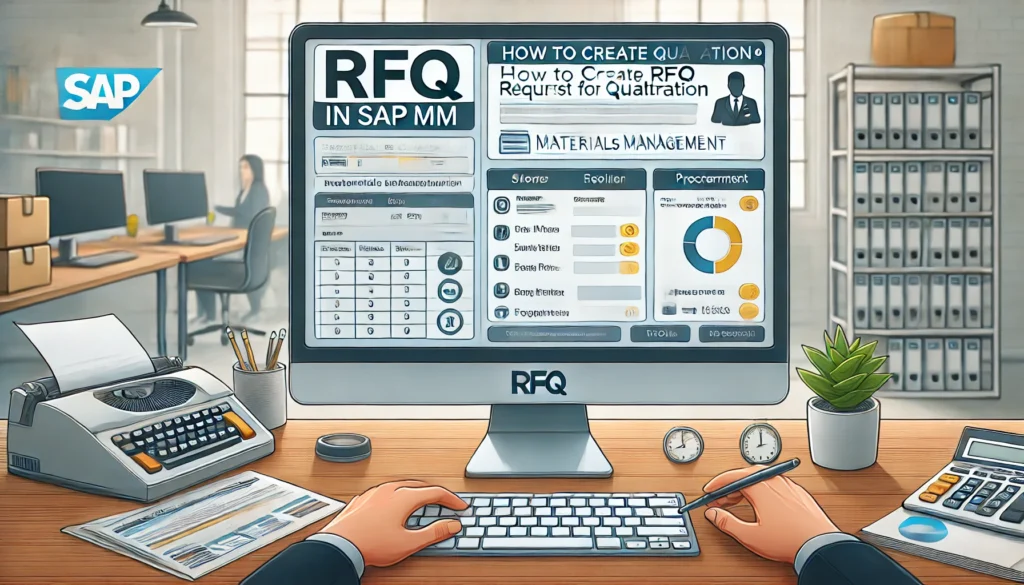Creating an RFQ (Request for Quotation) in SAP MM (Materials Management) involves several steps. An RFQ is created to invite vendors to submit quotations for the supply of materials or services. After receiving the quotations, the buyer can compare and select the most suitable offer.

Steps to Create RFQ in SAP MM
Transaction Code: ME41 (Create RFQ)
Step 1: Access the RFQ Creation Transaction
- Open the SAP system.
- Use the transaction code
ME41or follow the path:
SAP Menu → Logistics → Materials Management → Purchasing → RFQ/Quotation → Create
Step 2: Enter RFQ Details
- RFQ Type:
- Choose the appropriate RFQ type (e.g.,
ANfor standard RFQ).
- Choose the appropriate RFQ type (e.g.,
- Purchasing Organization:
- Enter the purchasing organization code (e.g.,
1000).
- Enter the purchasing organization code (e.g.,
- RFQ Date:
- Enter the date on which the RFQ is being created.
- Quotation Deadline:
- Enter the deadline date by which vendors should submit quotations.
- Vendor:
- Enter the vendor code if you already know the vendor.
- If you don’t know the vendor, you can leave it blank and enter it later.
- Document Type:
- Example:
AN(Standard RFQ).
- Example:
Also Read: What is Purchase Requisition (PR) in SAP MM?
Step 3: Enter Item Details
- Material:
- Enter the material number (if available).
- If no material number, you can describe the material in the “Short Text” field.
- Plant:
- Enter the plant where the material is required.
- Quantity:
- Enter the required quantity of the material.
- Delivery Date:
- Enter the expected delivery date.
- Purchasing Group:
- Enter the purchasing group responsible for this purchase.
- Material Group:
- Enter the material group for better classification.
Step 4: Enter Vendor Details
- Go to the Vendor Tab:
- Enter the vendor codes to whom the RFQ will be sent.
- If the vendor is not yet created, you can create a new vendor using
XK01orBP.
- Terms and Conditions:
- Enter payment terms, delivery terms, and any other specific requirements.
Step 5: Save the RFQ
- Click on “Save” (or press
Ctrl + S) to save the RFQ. - SAP will generate an RFQ number (e.g.,
6000001234).
Step 6: Output RFQ (Optional)
- To print or send the RFQ, use the transaction code:
ME9A– Output of RFQ - Enter the RFQ number and choose the output medium (e.g., Print, Email).
- Execute and confirm the output.
Step 7: Track and Monitor RFQ Status
- Use
ME43(Display RFQ) to check the RFQ status and details. - Use
ME4L(List of RFQs by Vendor) to monitor the list of RFQs.
Additional Notes
- RFQ in SAP is treated as a purchase document and can be converted into a Purchase Order (PO) after vendor selection using transaction code
ME21N. - After receiving quotations, you can maintain and compare them using
ME47(Maintain Quotation). - You can create a list of vendor quotations using
ME49(Price Comparison List).
Example Scenario
- You need to procure 100 units of steel pipes for plant 1000.
- Create an RFQ using
ME41, enter material details, assign vendors, and send the RFQ. - After receiving quotes from vendors, use
ME47to enter and compare quotations. - Finally, create a PO using
ME21Nbased on the best offer.